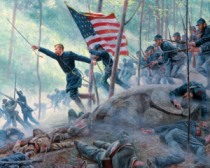 On July 2nd, 1863 Colonel Joshua Lawrence Chamberlain found himself fighting for his life – and the lives of his men. It was the second day of the Battle of Gettysburg. Chamberlain and his regiment, the 20th Maine, were positioned on a small hill called Little Round Top. They were the end of the line, the extreme left flank of the Union Army’s defensive position – and their enemy knew it. Both sides knew that if the Confederates broke the 20th Maine, they could sweep through and take the entire Federal Army from behind.
On July 2nd, 1863 Colonel Joshua Lawrence Chamberlain found himself fighting for his life – and the lives of his men. It was the second day of the Battle of Gettysburg. Chamberlain and his regiment, the 20th Maine, were positioned on a small hill called Little Round Top. They were the end of the line, the extreme left flank of the Union Army’s defensive position – and their enemy knew it. Both sides knew that if the Confederates broke the 20th Maine, they could sweep through and take the entire Federal Army from behind.
The situation was bleak for the Union soldiers. Attack after attack by the 15th Alabama had decimated their ranks. They were out of ammunition. As the Confederates reformed for another assault, Chamberlain knew this one would finish them off. There were only two options:
1. Retreat: Try to save themselves and fail to hold the flank.
2. Stay: Fight and die as the Confederates overran their position and broke into the rear.
Both of these options were unacceptable to Chamberlain. So he chose Option 3: Attack. The enemy had to be tired, he reasoned, and his men would have the advantage of moving downhill coupled with the elements of shock and surprise. “BAYONETS!” came the order and it spread through his remaining soldiers like wildfire.
As the Confederates attacked up the hill, Chamberlain launched his men down the hill. In a simultaneous frontal assault and flanking maneuver they swept down on their stunned attackers. The ranks of the 15th Alabama quickly broke. Chamberlain and the 20th Maine had turned certain defeat into a tremendous victory.
Though they didn’t know it at the time, this small victory was key to the Union victory at Gettysburg, the battle that most historians consider the turning point in the Civil War.
So, what’s your option 3?
- Click to share on X (Opens in new window) X
- Click to share on Facebook (Opens in new window) Facebook
- Click to share on LinkedIn (Opens in new window) LinkedIn
- Click to share on Reddit (Opens in new window) Reddit
- Click to email a link to a friend (Opens in new window) Email
- Click to print (Opens in new window) Print